One of the great things about living in the Pacific Northwest is its connection to aviation. Just about 10 miles north of where I live, is the Future of Flight (FoF), which is right next to Paine Field in Everett. The FoF was opened in December 2005 with collaboration between The Boeing Company, Future of Flight Foundation, Snohomish County Public Facilities District and the Snohomish County Airport(Paine Field) with the idea of showcasing the future of commercial aviation. Even though Boeing is a supporter and offers their Boeing tour from the same location, the FoF does not limit their displays to only Boeing products, but shares the history, present, and future of all commercial aviation brands. The $23million project attracts about 175,000 visitors from 175 different countries every year. This was all too tempting to pass up and I was invited to check out what they have to offer first hand.
When I arrived, I was greeted by Sandy Ward, Marketing Director, and Ed Kaplania, Projects Manager (and aviation genius). For about the next hour and a half, they would be my tour guides showing me all the wonders of the FoF. The first thing I noticed was they had a Beechcraft Starship hanging on their ceiling; it was then, I knew I was going to fall in love with this place.
My favorite part of the visit was the cockpit of a Boeing 727-200. The plane was donated by>>>. I was amazed with all the switches, buttons, lights, and fuses. I probably sat in the cockpit for 30 minutes. I felt like a 12 year old kid, having to flip all the switches and getting satisfaction from the tactile feel of each switch’s throw. Outside of the cockpit there is a virtual tour of the new Boeing 787 “glass cockpit” What a stark difference! The FoF plans to add a physical “glass cockpit” to put next to the 727’s so visitors can see first hand the vast difference. Although the newer cockpits are much more advanced, need only two (well really one) people, and have far fewer switches, there seems to be some connection lost between the pilot and plane.
Around the main floor there are computer monitors where visitors can design their own aircraft. They can choose fuselage size, wing size, materials, etc. As you change each option , the program tells you how many miles the plane will fly, the passenger load, the fuel efficiency, etc. I was quite entertained trying the different options and it took me a while to realize I was actually learning things about how the design affected the stats of the aircraft. I was very happy with my end result (Can hold 451 people in a 2-class layout and go 18,000 miles — which I know any plane that can go over 12,000 miles is pretty useless, but whatever, it looks awesome). After you are happy with your design, you are able to print off a copy in the gift shop for free.
There are a few high tech and static displays that allow you to explore the workings of a jet engine. One is able to explore the difference between the rivet/panel approach to the old Boeing 707, versus the smooth, single panel approach to composite materials. There is a mock up of the interior of the new Boeing 787, as well as one from a 767. You can spend a few hours reading about the histories of all the commercial jets, which is almost what I did.
Then to top it off, there is a roof-top viewing area that overlooks Paine Field. To the left, one can see the hangars where all the magic happens. Straight ahead is a Dream Lifter that flies the Boeing 787 parts around the globe, and to the right are new planes (including the Boeing 787) ready to fly. They also have the traffic control on speakers, so you can hear what is going on. Unfortunately it was rainy, cold, windy, and getting dark, so I wasn’t able to stick around long enough to catch a glimpse of a takeoff. When it is clear out, one can see the Cascade Mountains, Mount Rainier, and Mount Baker while watching airplanes taking off and landing. Yes folks, this is pretty much aviation nerd heaven (only if they had a cafe up there).
For those who like aviation shopping, have no fear — there are two options. First you have the Future of Flight gift shop, with some aviation and northwest themed items, but you also have the Boeing gift shop, where I could easy spend a few grand without thinking. I contemplated not going into either (to stop the temptation of spending money), but how could I refuse? Luckily I walked out with only one model of a Alaska Airlines Boeing 737; it took a lot of will power.
If you like aviation and you are in the Seattle area, you need to check out the Future of Flight. It is a growing collection with many new exciting features planned. Guests also have the ability to take the Boeing Tourhttp://www.futureofflight.org/planavisit.html#BoeingTourInformation, which I hope to return and take soon. Don’t worry, when I do, I will be sure to let you know how it goes!
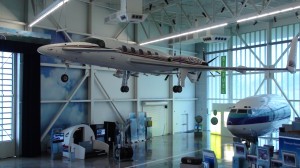
The main area of the Future of Flight. Up is the Starship, to the right, the front end of a B727, on the bottom, a B727 cockpit.
One of the great things about living in the Pacific Northwest is its connection to aviation. Just about 10 miles north of where I live, is the Future of Flight (FoF), which is right next to Paine Field in Everett. The FoF was opened in December 2005 with collaboration between The Boeing Company, Future of Flight Foundation, Snohomish County Public Facilities District and the Snohomish County Airport (Paine Field) with the idea of showcasing the future of commercial aviation. Even though Boeing is a supporter and offers their Boeing tour from the same location, the FoF does not limit their displays to only Boeing products, but shares the past, present, and future of all commercial aviation brands. The $23 million project attracts about 175,000 visitors from 175 different countries every year. This was all too tempting to pass up and I was invited to check out what they have to offer first hand.
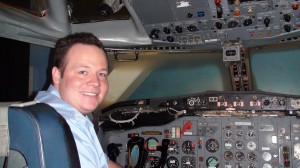
The Airline Reporter himself inside the cockpit of the Boeing 727 with all the buttons and lights.
When I arrived, I was greeted by Sandy Ward, Marketing Director, and Ed Kaplania, Projects Manager (and aviation genius). For about the next hour and a half, they would be my tour guides showing me all the wonders of the FoF. The first thing I noticed was they had a Beechcraft Starship hanging on their ceiling; it was then, I knew I was going to fall in love with this place.
My favorite part of the visit was the cockpit of a Boeing 727-200. I was amazed with all the switches, buttons, lights, and fuses. I probably sat in the cockpit for 30 minutes. I felt like a 12 year old kid, having to flip all the switches and getting satisfaction from the tactile feel of each switch’s throw. Outside of the cockpit there is a virtual tour of the new Boeing 787 “glass cockpit” What a stark difference! The FoF plans to add a physical “glass cockpit” to put next to the 727’s so visitors can see first hand the vast difference. Although the newer cockpits are much more advanced, need only two (well really one) people, and have far fewer switches, there seems to be some connection lost between the pilot and plane.
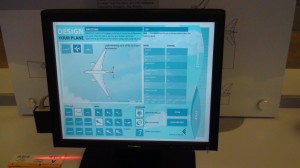
Use computers around the FoF to build your own airliner. The program told me the wings were too small on this one, but I didn't care.
Around the main floor there are computer monitors where visitors can design their own aircraft (see pic to the left). They can choose fuselage size, wing size, materials, etc. As you change each option, the program tells you how many miles the plane will fly, the passenger load, the fuel efficiency, etc. I was quite entertained trying the different options and it took me a while to realize I was actually learning things about how the design affected the stats of the aircraft. I was very happy with my end result (can hold 451 people in a 2-class layout and go almost 19,000 miles — which I know any plane that can go over 12,000 miles is pretty useless, but whatever, it looks awesome). After you are happy with your design, you are able to print off a copy in the gift shop for free.
There are a few high tech and static displays that allow you to explore the workings of a jet engine (I got to climb into one, kind of scary). One is able to explore the difference between the rivet/panel approach to the old Boeing 707, versus the smooth, single panel approach to composite materials. There is a mock up of the interior of the new Boeing 787, as well as one from a 767. You can spend a few hours reading about the histories of all the commercial jets, which is almost what I did.
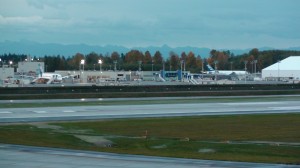
Yes, you can see two Boeing 787's from this view.
Then to top it off, there is a roof-top viewing area that overlooks Paine Field. To the left, one can see the hangars where all the magic happens. Straight ahead is a Dream Lifter that flies the Boeing 787 parts around the globe, and to the right are new planes (including the Boeing 787) ready to fly. They also have the traffic control on speakers, so you can hear what is going on. Unfortunately it was rainy, cold, windy, and getting dark, so I wasn’t able to stick around long enough to catch a glimpse of a takeoff. When it is clear out, one can see the Cascade Mountains, Mount Rainier, and Mount Baker while watching airplanes taking off and landing. Yes folks, this is pretty much aviation nerd heaven (only if they had a cafe up there).
For those who like aviation shopping, have no fear — there are two options: first you have the Future of Flight gift shop, with some aviation and northwest themed items, but you also have the Boeing gift shop, where I could easily spend a few grand without thinking. I contemplated not going into either (to stop the temptation of spending money), but how could I refuse? Luckily I walked out with only one model of a Alaska Airlines Boeing 737; it took a lot of will power.
If you like aviation and you are in the Seattle area, you need to check out the Future of Flight. It is a growing collection with many new exciting features planned. Guests also have the ability to take the Boeing Tour, which I hope to return and take soon. Don’t worry, when I do, I will be sure to let you know how it goes!
SEE THE REST OF THE PICTURES HERE.
follow via | web | twitter | email | rss |
Ryanair Might Stop Growth Due to No Planes
Ryanair has over 200 Boeing 737-800’s, which allows them to save on maintenance, training, parts, etc. However, this also lessens their ability to negotiate effectively if Boeing knows Ryanair is not likely to start buying other aircraft types.
Ryanair is one of Europe’s biggest airlines and they feel they can keep growing. They are so confident about their ability to grow, they are looking to purchase another 200 airplanes and they say Boeing is not working hard enough to make a good deal.
“We see no point in continuing to grow rapidly in a declining yield environment, where our main aircraft partner is unwilling to play its part in our cost reduction programme,” Michael O’Leary, the famous CEO for Ryanair, said about the situation.
O’Leary says they have cash on hand and if Boeing doesn’t want it, they will just pay their stockholders in dividends instead (why not put the money to providing some actual customer service? Nah’¦).
This seems it might just be O’Leary doing what he does, trying to squeeze every last dime out of Boeing. I find it hard to believe that Ryanair would move to having two aircraft types or willing to shell out the money to convert their entire fleet into one. My bet is either they really don’t want to buy 200 planes or if they do, they will all be Boeing 737’s.
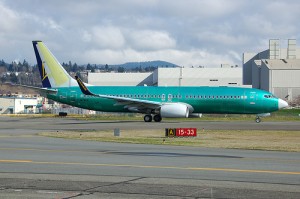
Take a look at the winglet and tail. This is a new Boeing 737-800 for Ryanair.
Ryanair has over 200 Boeing 737-800’s, which allows them to save on maintenance, training, parts, etc. However, this also lessens their ability to negotiate effectively if Boeing knows Ryanair is not likely to buy other aircraft types.
The airline is one of Europe’s biggest and they feel they can easily keep growing. They are so confident about their ability to grow, they are looking to purchase another 200 airplanes, but they say Boeing is not working hard enough to make a deal.
“We see no point in continuing to grow rapidly in a declining yield environment, where our main aircraft partner is unwilling to play its part in our cost reduction programme,” Michael O’Leary, the famous CEO for Ryanair, said about the situation.
O’Leary says they have cash on hand and if Boeing doesn’t want it, they will just pay their stockholders in dividends instead (why not put the money to providing some actual customer service? Nah’¦).
This seems it might just be O’Leary doing what he does, trying to squeeze every last dime out of Boeing. I find it hard to believe that Ryanair would move to having two aircraft types or willing to shell out the money to convert their entire fleet into one. My bet is either they really don’t want to buy 200 planes or if they do, they will all be Boeing 737’s.
follow via | web | twitter | email | rss |
Source: Airwise Image: drewski2112
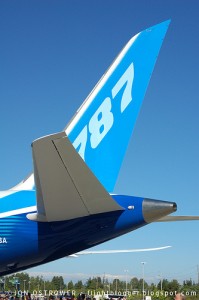
Tail of the Boeing 787
It has been hard to think about this with an outside perspective. I grew up in the Seattle area; I remember as a child driving by the large hangars in Everett, hoping they would be open so I could sneak a peek at what they were building. I recently bought a house and was delighted to find out it was on one of the flight paths for the airport where Boeing builds the 747, 777, and 787. Recently I was lucky enough to catch a Dreamlifter flying overhead, which others might find as a negative, but as an aviation nerd, I love it!
Due to my attachment to Boeing as a local company, my initial reaction to Boeing choosing South Carolina for their 2nd assembly line for the Boeing 787 was shock. How could they? Of course, many on the local media felt the same and you could see the anger and disappointment. There was a lot of blame. Some said it was the union. Others said that local government wasn’t doing enough. Others said the move of Boeing’s headquarters to Chicago should have been the warning sign.
But after taking some time and reading a lot about their decision, I have to say I understand it. I realize why Boeing made this decision and it is not just one factor. Here are the reasons I feel it might have been a wise choice:
* Cost of living: The Seattle area is well known for having a high cost of living. We have a lot of big companies housed here: Boeing, Microsoft, Amazon, and Starbucks, just to name a few. Along with these big names come big paychecks. For Boeing to keep qualified workers in the Seattle area, they have to pay them higher wages. Charleston doesn’t have the high cost of living that Seattle does.
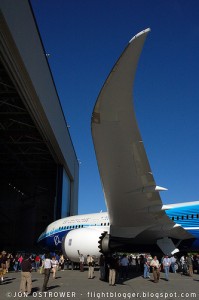
Wing of the Boeing 787 Dreamliner
* Less environmental concerns: Seattle would like to say it’s a green, environmentally friendly city. Even though no city would want to admit they aren’t, Charleston and South Carolina don’t have the environmental restrictions that Seattle and Washington state have.
* No union labor force: Boeing workers in the Seattle area have grown large unions. These unions have helped many workers get the rights and pay they have today, but unions can take a big chunk out of Boeing’s bottom line. The unions have gone on strike multiple times in the Seattle area, causing billions in loses. By using a non-unionized workforce in Charleston, Boeing doesn’t have to worry about their workers going on strike.
* Moving global: Boeing has created a global supply chain that makes needing all production in the same place obsolete. Of course some can argue this new global supply chain has caused some of the delays for the 787 Dreamliner, but it is most likely the future model of airplane construction.
* Defense contracts: Boeing doesn’t just build commercial airliners. They have multi-billion dollar defense contracts. To help them keep these contracts, they need to spread jobs and production across the US as much as possible.
This doesn’t seem like a quick decision on Boeing’s part. With plans to start construction next month and planes to be completed by 2012, one can only assume that they had their mind made up for quite some time. Most who work on the current 787 line in Everett feel cheated. However, this might be a great opportunity to show they are the best and they are worth the extra money. Boeing will soon be looking at building a replacement for the Boeing 737 and 777 and the union and workers have the opprotunity to show that Everett is the right place for Boeing to build. I believe that is true and I hope Boeing will be able to see this in the future.
Although I like to think of Boeing as this place that creates wonderful flying machines, they are a business and need to do what is best for their future. I hope that Boeing can see that no one other than the Boeing workers in the Seattle area can build a better plane!
follow us via | web | twitter | email | rss |
Images: Flightblogger
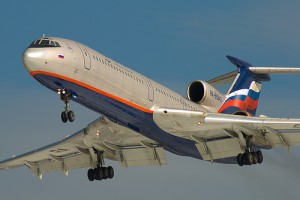
Aeroflot - Russian Airlines, Tupolev Tu-154M RA-85642 (cn 88A778)
Aeroflot, Russia’s largest carrier, is planning to rid its fleet of Tupolev TU-154 jets and acquiring additional Boeing and Airbus aircraft. It is planning to sell its remaining Tupolev jets, but the airline will still have six Russian built Illyushin Il-96’s to handle some international flights.
This is a big change from an airline that at one time had no Boeing or Airbus aircraft. Aeroflot is hoping to cater more to business travelers and TU-154’s are not known for their quality or silence.
Aeroflot also is looking to lower the cost of its routes. The airline’s chief executive, Vitaly Savelyev, explained the airline is currently losing money on 40% of its routes and looking to avoid thousands of layoffs over the next few years. Instead they are hoping the improved savings with fuel consumption, less maintenance costs, and increase traffic due to flying newer aircraft will allow the airline to avoid layoffs.
With the current global economy and the fact there are hundreds of other older Boeing and Airbus aircraft sitting in the desert, it will most likely be difficult for Aeroflot to find buyers for its 26 TU-154s. Personally it is a bit sad to not be able to see a TU-154 in Aeroflot livery, however it would be worth it to someday see a Boeing 747 or Airbus A380 in the airline’s livery.
Image: osdu

Boeing 787 at the Everett, WA plant
Is Boeing threatening to move jobs out of Washington State unless their labor union commits to a no-strike clause in the next contract? I was waiting for a bit more information on the reports of Boeing’s ultimatum to their Washington machinists’ union before blogging about it, but details have not been forthcoming since U.S. Representative Norm Dicks from Washington broke the story a couple of weeks ago:
“The whole thing comes down to, can they get a long-term agreement with the union, with a no-strike clause. That’s what ultimately has to happen here in the next two or three or four months or they are going to go elsewhere. I think if they get this agreement, they would stay.”
The no-strike clause rumor comes in the wake of Boeing’s purchase of a 787 rear fuselage production plant in South Carolina ’“ prompting concerns that Boeing will move more of its production out of the Everett and Renton, Washington plants.
The International Association of Machinists and Aerospace Workers, AFL-CIO District 751, who represents Boeing’s machinists in the Pacific Northwest, issued a statement assuring members that no proposal on a no-strike clause had been presented by Boeing. They also expressed disappointment with Boeing allowing rumors to spread this way: ’œTo use politicians as microphones to deliver a message, creates problems and does nothing to improve the relationship [between Boeing and the Machinists’ Union].’ That being said, the union asserts that they will look at any possible routes to keeping jobs in the state.
Washington State greatly benefits from the two large Boeing plants, and I’m sure residents would hate to see more Boeing jobs go out of state. Boeing has also been hemorrhaging money in the delayed production of the Dreamliner Boeing 787, so I can understand their desire to avoid costly strikes that could cause further delays. Boeing’s method of self-preservation, however, leaves a bad taste in the mouth, and I tend to feel for the union’s dismay over having all this leaked to the media before sitting down with labor. It will be interesting to see how negotiations pan out, and how strong public opinion will play a part.
Sources: Seattle Times, IAM District 751 Image: andyconniecox








